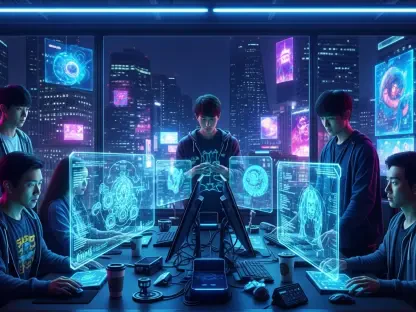In an era where digital deception is becoming increasingly sophisticated, the rise of AI-generated faces poses a significant threat to security and trust online, creating a pressing need for advanced detection technologies. Picture a scenario where a fake social media profile, powered by a hyper-realistic synthetic face, dupes thousands into believing a fabricated narrative or, worse, bypasses identity verification systems for fraudulent purposes. This alarming reality underscores the urgent need for robust detection mechanisms. As AI tools evolve to create faces that often appear more convincing than real ones, the challenge of distinguishing fact from fiction intensifies. This review delves into the cutting-edge field of AI-generated face detection, examining the technology behind synthetic face creation, the latest detection strategies, and their implications for security in a digitally dominated landscape.
Core Technology Behind AI-Generated Faces
Unveiling StyleGAN3’s Sophistication
At the forefront of synthetic face generation stands StyleGAN3, a generative adversarial network that has redefined realism in AI-created imagery. This technology leverages advanced machine learning algorithms to produce faces with intricate details, from skin texture to facial expressions, often surpassing human perception of authenticity. Its ability to generate diverse and highly convincing faces has made it a benchmark in the field, yet it also amplifies risks in areas like identity fraud and misinformation campaigns.
Despite its prowess, StyleGAN3 is not without flaws that detection systems can exploit. Subtle rendering errors, such as unnatural transitions in hair strands or asymmetrical facial features, provide critical clues for differentiating synthetic faces from real ones. These imperfections, though minor to the untrained eye, form the foundation for developing detection algorithms and training programs aimed at countering the technology’s deceptive potential.
Identifying Flaws in Synthetic Imagery
A closer examination of AI-generated faces reveals consistent patterns of error that serve as telltale signs. Irregularities in dental alignment or inconsistent lighting reflections in the eyes often betray the artificial nature of these images. Such discrepancies, while sometimes imperceptible in casual viewing, are pivotal for training both human observers and automated systems to spot fakes with greater accuracy.
Beyond visual cues, the structural logic of synthetic faces can also falter under scrutiny. For instance, the way facial features interact with background elements might lack the natural harmony seen in authentic photographs. By cataloging these recurring issues, researchers have begun to build a framework for detection that capitalizes on the limitations of even the most advanced generative tools.
Advances in Detection Methodologies
Short Training Interventions Yield Results
Recent strides in detection techniques have shown remarkable promise, particularly through brief educational interventions. Studies demonstrate that a mere five-minute training session, focusing on common rendering mistakes in AI-generated faces, can significantly enhance an individual’s ability to identify fakes. This approach has proven effective across diverse groups, from those with average recognition skills to exceptional super-recognizers.
The training emphasizes practical strategies, such as scanning for unnatural hair patterns or mismatched facial proportions, empowering participants to overcome initial challenges in detection. This rapid improvement suggests that accessible education could play a vital role in equipping the public and professionals alike to combat digital deception. The scalability of such interventions offers hope for widespread adoption in security protocols.
Synergy of Human and Machine Capabilities
Emerging trends point toward a hybrid model that combines human perception with technological innovation. While AI detection tools excel at processing large datasets for anomalies, human intuition remains uniquely adept at interpreting nuanced visual cues. Integrating these strengths could create a more robust defense against synthetic media, addressing gaps that neither approach can tackle alone.
Research continues to explore how natural aptitudes, especially among super-recognizers, can complement automated systems. This collaborative framework aims to adapt to the ever-evolving sophistication of generative technologies, ensuring that detection methods remain relevant. As threats grow more complex, this balanced strategy holds potential for long-term resilience in digital security.
Real-World Impact and Security Concerns
Applications Across Critical Sectors
AI-generated face detection finds practical utility in multiple domains, notably on social media platforms where fake profiles proliferate. By implementing detection tools, these platforms can curb the spread of misinformation and protect users from scams. Similarly, in identity verification for banking or governmental services, such technology helps prevent unauthorized access driven by forged visuals.
Document authentication represents another crucial area of application. Synthetic faces have been misused to create fraudulent IDs, undermining trust in official records. Detection systems, supported by trained personnel, are increasingly integrated into verification workflows to flag discrepancies and safeguard institutional integrity against such breaches.
Mitigating Risks of Misuse
The misuse of AI-generated faces extends beyond individual deception to broader societal impacts, including election interference through fabricated personas. High-profile cases have exposed how easily synthetic imagery can manipulate public opinion, highlighting the stakes involved. Detection training and tools serve as a frontline defense, reducing the likelihood of successful exploitation in these sensitive contexts.
Addressing these risks requires not just technological solutions but also policy frameworks that keep pace with innovation. Regulatory gaps currently hinder comprehensive responses to synthetic media, necessitating urgent collaboration between tech developers, lawmakers, and security experts. This multifaceted approach aims to minimize vulnerabilities in an interconnected digital ecosystem.
Challenges in Keeping Pace with Innovation
Rapid Technological Evolution
One of the most pressing obstacles in AI face detection is the relentless advancement of generative technologies. As tools like StyleGAN3 become more refined, detection methods struggle to match their sophistication, often lagging behind the latest deceptive capabilities. This dynamic creates a persistent cat-and-mouse game between creators and detectors.
Human perception, even when trained, faces limitations in adapting to these rapid changes. Initial performance among untrained individuals remains poor, underscoring the need for continuous updates to training content. Without sustained efforts, the gap between generative and detection technologies risks widening, amplifying security threats.
Addressing Regulatory and Training Gaps
Beyond technical hurdles, the absence of cohesive regulations poses a significant barrier. The legal and ethical implications of synthetic media remain inadequately addressed, allowing misuse to flourish in gray areas. Establishing clear guidelines is essential to ensure accountability and deter malicious applications of AI-generated content.
Training programs, while effective in the short term, require evaluation for lasting impact. Current research indicates uncertainty about how long detection skills persist after training, prompting calls for longitudinal studies. Developing adaptive curricula that evolve with technology will be critical to maintaining efficacy over time.
Future Pathways for Detection Technology
Exploring Long-Term Training Effects
Looking ahead, a key focus lies in assessing the durability of training interventions. Determining whether detection skills diminish over time or can be reinforced through periodic refreshers will shape the design of future programs. Such insights are vital for creating sustainable solutions that empower individuals against digital fraud.
Additionally, tailoring training to specific contexts, such as professional security roles, could enhance its relevance. Customized modules focusing on sector-specific threats might yield even greater accuracy, ensuring that detection capabilities align with real-world demands. This targeted approach promises to maximize impact across diverse applications.
Hybrid Models and Super-Recognizer Integration
The potential of combining super-recognizers’ innate talents with AI tools offers an exciting frontier. These individuals, with their exceptional face recognition abilities, could provide unique insights to refine automated systems, creating a synergy that leverages the best of both worlds. Pilot projects in this area are already underway, signaling a shift toward integrated detection strategies.
Anticipated breakthroughs in hybrid models aim to address the scalability of detection efforts. By embedding human expertise into AI frameworks, the technology could adapt more dynamically to new generative threats. This forward-thinking vision seeks to build a resilient defense mechanism capable of safeguarding digital trust for years to come.
Final Reflections on AI Face Detection
Reflecting on this comprehensive evaluation, it becomes evident that AI-generated face detection stands as a pivotal tool in countering digital deception, with short training interventions markedly improving human accuracy. The exploration of StyleGAN3’s capabilities revealed both its impressive realism and exploitable flaws, while real-world applications underscored its dual role as a security asset and potential risk. Challenges like rapid technological evolution and regulatory gaps emerged as significant hurdles that demand attention.
Moving forward, actionable steps include prioritizing the development of hybrid detection models that fuse human intuition with machine precision. Stakeholders are encouraged to invest in longitudinal research to gauge the lasting effects of training, ensuring that skills remain sharp over time. Collaboration between tech innovators and policymakers also emerges as a crucial next step to close regulatory loopholes and establish ethical standards. Ultimately, these concerted efforts aim to fortify defenses against synthetic media, preserving trust in an increasingly complex digital landscape.









